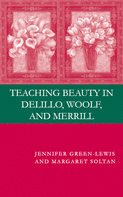Green-Lewis and Soltan, Teaching Beauty
 The Department of English offers its warm congratulations to faculty members Jennifer Green-Lewis and Margaret Soltan. Their coauthored book Teaching Beauty in DeLillo, Woolf, and Merrill has just been published by Palgrave. The book’s description:
The Department of English offers its warm congratulations to faculty members Jennifer Green-Lewis and Margaret Soltan. Their coauthored book Teaching Beauty in DeLillo, Woolf, and Merrill has just been published by Palgrave. The book’s description:
What happened to beauty? How did the university literature classroom turn into a seminar on politics? Focusing on such writers as Don DeLillo, Virginia Woolf, and James Merrill, this book examines what has been lost to literature as a discipline, and to literary criticism as a practice, as a result of efforts to reduce the aesthetic to the ideological. Green-Lewis and Soltan celebrate the return of beauty as a subject in its own right to literary studies, a return all the more urgent given beauty’s ability to provide not merely consolation but a sense of order and control in the context of a threatening political world.
If that paragraph does not sufficiently whet your appetite, we offer the preface to the volume below.
Preface
“How shall the heart be reconciled/ to its feast of losses?” asks Stanley Kunitz in his poem “The Layers.”[i] As Kunitz clearly knew, there are actually a few things available to us in a time of grief that, if they cannot reconcile the heart, at least may turn the shapelessness of loss into the consolation of elegy. This book is about one of them. It is intended, first and foremost, for our students who, after their early morning encounters with the world via CNN, appear in our classrooms to talk about Ruskin or Thackeray or Nabokov. How shall their hearts be “reconciled” to the world in which they find themselves? Why, they might well ask, should they study literature, amid the ongoing global feast of losses?
Our response to that question, and the starting point for this book, is our belief that beauty, and specifically, the beauty to be experienced in literature, is one of the things that can offer our students consolation, can give them forms in which to shape their own present and future grief and joy. There have been times–on September 12, 2001, for example, while the sky visible from our classroom still bore traces of smoke over the Pentagon–when as teachers of literature we have felt ourselves at an almost grotesque remove from the misfortunes of the world. But our recognition of that remove also recharges our daily awareness of the extraordinary privilege that it is to be in the classroom with our students. As teachers of literature, we are not only intellectually excited but also ethically obliged to make the beauty of literature–the reconciliation to our world that a written work may offer–a part of our discussion of a work.
And certainly there is plenty of thinking about beauty going on, unfashionable as it has been in recent years to acknowledge it. Notwithstanding the shifting tastes of literature departments, beauty has never abandoned the province of literature, nor have readers failed over past decades to appreciate it. Our argument in this book, however, is that in its evolution into literary and cultural studies, what used to be called Literary Criticism failed to bring along with it what was once also part of its purview: namely, an appreciation of, and the skills to describe, the aesthetic life of a work. As teachers of literature started to move beyond the textually prescribed boundaries of close literary analysis to pursue historical, political, and theoretical approaches to literary works, we stopped making time to let our students talk about beauty, and we failed to teach them a formal vocabulary with which to do it.
The conclusions we draw in this book result from our own experience as teachers of literature; as people, that is, who like to read, and who teach other people how to read, and how to write about what they read. In another age, we might have said that we were literary critics, but in academia today that term has a quaintness about it that brings to mind worthy but impossibly tweedy figures such as the Leavises. Today’s successful literary critic writes for a periodical, such as the New York Review of Books, and is rarely found in the halls of the English department.[ii] We don’t often teach literary criticism at universities any more; at least, not the kind of literary criticism involving the kind of close reading, evaluation, and judgment which are required for writing a decent book review.
This may be because, as with so many things in America, the thing that once was literary criticism has grown much larger in the past twenty-five years; while, paradoxically, in their various conceptual expansions, English departments have simultaneously made less and less space available for serious study of aesthetic questions –those questions pertaining, that is, to questions of beauty. We believe that a relentless focus in the college classroom on the work of art as cultural production, or on the creation of its readership, and an emphasis on what or whom a text may represent and whose rights or interests are slighted by it, have led to a culture of criticism full of its own special interests; while its neediest practitioners–our students—have been too often starved of the pleasures–the reconciliations–of the work itself.
Why does a work move us? How do we explain the pleasure, or discomfort, given us by a particular couplet, or arrangement of words, or indeed any literary device? What is the nature of our aesthetic response and can we identify what has elicited it? Open questions such as these that offer a grounded point of entry into the discussion of a work of literature or art have been asked far too rarely over the past thirty years, while other questions have become, as a result, burdened with complexity and often regarded as off limits. For example: How do we justify the choices we make when we judge between works, as judge we must?[iii] What does it mean to say that something is well or poorly written? How can students of literature and art–how can anyone–identify any artwork as definitively bad–or good?
[i] Stanley Kunitz, “The Layers.” The Collected Poems of Stanley Kunitz (New York: Norton, 2000), p. 217.
[ii] There are, happily, exceptions. James Wood, senior editor of The New Republic and chief literary critic for The Guardian, currently teaches in the English Department at Harvard, and continues to write informed, accessible, and widely-read literary criticism. Louis Menand, also of Harvard, and Michael Wood at Princeton are, similarly, “cross-overs” whose work reaches a wide audience and remains fully identifiable as literary criticism.
[iii] If we are teachers we must judge what is worth teaching; and as readers we must presumably decide what is worth our time. Why should a class on British Literature make space for Virginia Woolf and E. M. Forster but none for the far more widely read Marie Corelli? One obvious answer: life is short.
———————-
Margaret Soltan also gave a talk to the GW Undergraduate Philosophy Club on the evening of April 7. Titled Better Living Through Consciousness: Why You Should Take Your College Education Seriously, it can be read at her blog, University Diaries, at Inside Higher Education.
